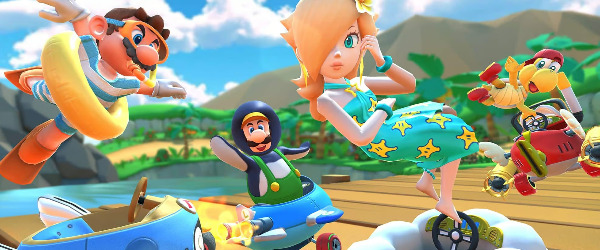
The 10 Best Open Worlds Available on Vita - Article
by Adam Cartwright , posted on 04 March 2018 / 9,803 ViewsOnce Grand Theft Auto III landed on the PS2 it felt like the landscape of gaming changed substantially – slowly but surely other franchises embraced the open-world design of having big hub worlds with dozens of side tasks within them. This was seen more and more during the seventh generation of home consoles and especially into the eighth (even trickling down to handhelds like the PSP), with multiple series re-inventing themselves with an open-world design.
Vita is no stranger to this, with a number of games coming to the handheld that offered a true free-roaming experience, allowing you to go nearly anywhere and do nearly anything whenever you please. In this article I aim to examine the best of these that are available on the Vita; the open-worlds that allow the greatest feeling of freedom, exploration, and escapism on the platform.
I won’t be including any semi-open world games (e.g. titles like Akiba’s Trip, which feature open areas that you have to use loading screens to travel between) or games with hub-worlds (e.g. titles like LEGO Batman 3, where you can explore the bat-cave at will but otherwise just move through a series of levels). I’ll also be keeping my choice to one game per franchise, so as to avoid listing multiple entries in the same series and clogging up the list (otherwise three-tenths of the titles featured would be Grand Theft Auto games!).
Fairhaven – Need for Speed: Most Wanted
The Need for Speed series has often dabbled with open-worlds. I fondly remember, for example, playing Need for Speed: Underground 2 back in the day and being really impressed with its free-roaming aspects. A number of the PSP entries attempted to recreate this – most notably Carbon: Own the City, but just as with the PSP Assassin’s Creed game, they didn’t quite pull it off.

On Vita, with its increased horsepower, Criterion Games was finally able to realise this vision with its brilliant revival of Most Wanted – an open-world racing game which allowed you to go wherever and do whatever you wanted, enhanced by the addition of ‘autolog’, which added a quick-access menu that allowed you to zip around to the next event.
Fairhaven is a brilliant city full of totally unique zones. In one drive, and with no loading screens, you can head from the urban city centre through to the dockland, and then into winding cliff-side lanes, each evoking a different feeling during the ride. Additionally there are loads of interactive elements like speed traps and billboards to smash. You can also switch vehicle at the push of a button, and everything is as smooth as butter, making this a brilliant open-world experience.
Heskeville – Gravity Rush
Sometimes it’s not the world itself, but how you interact with it. In the case of Gravity Rush, its movement mechanics are almost unrivalled on Vita – Kat can soar through the air, land upside-down on a building, then take off again to reach another location with a brilliant sense of momentum throughout. In this way, the feeling of freedom in the world is fantastic – if you can see something, chances are you can go there.

Of course, Heskeville itself is a brilliant place – a bustling city full of skyscrapers, train stations, and plazas that feel like unique and enjoyable places to explore, littered with objects Kat can throw around using gravity. And thanks to the bold visual design and expressive colour palette, everything manages to pop on the Vita’s screen to remain incredibly memorable long after you’ve finished playing.
The addition of NPCs who can float off if you invert gravity around them and the Nevi who lurk around every corner help create a living, dynamic world and this is one of Gravity Rush‘s greatest strengths. It’s such a shame the sequel never saw light of day on the Vita as Kat made a fantastic mascot for the console and her brand of open-world adventuring still feels unmatched on handhelds, whereas it’s more run-of-the-mill on home consoles.
Kyoto – Ukiyo no Roushi
Unique among the games on this list, Ukiyo no Roushi uses a historical city for its setting – namely Kyoto, the former imperial capital of Japan. It provides a brilliant alternative to the more modern metropolises available on the console. You’re more likely to find sacred shrines, cherry blossom trees, and swordfights in this city than skyscrapers, neon signs, and shootouts.

Taking more than a little inspiration from the Way of the Samurai series, Ukiyo gives you free reign in Kyoto, meaning you can really do what you feel like. Craft weapons, take pictures, or get involved in brawls (although you can’t cause quite as much havoc as in the aforementioned franchise) - it’s a nice sandbox to play in even if the language barrier will cause some issues (why this game wasn’t translated into English I’ll never know).
With a wide variety of missions and side stories to keep you pushing forward, you’ll eventually explore every corner of the map and, although the pace can be a little plodding, it’s definitely a unique open world and well worth checking out.
Manhattan – Amazing Spider-Man
Some franchises just yearn for a big, open world to explore. Spider-Man is very much one of those series. Web-slinging through the streets of New York has always been a dream and although it was somewhat achieved on handhelds with the PSP versions, it came to an apex with Amazing Spider-Man on Vita.

Although it was slated by some outlets for its questionable physics (your web could connect to the sky rather than requiring a building to latch onto), the sense of freedom this gave was undeniable. You really felt like Spidey by taking to the rooftops, seeing a faraway place and slowly making your way there alongside the cab-filled streets of New York, taking in the familiar sights of soaring skyscrapers along the way.
Aiding the enjoyable open-world were a number of side quests ranging from saving civilians to stopping escaped vehicles and finding a number of hidden comic book pages, the latter of which required true mastery of the city to find every nook and cranny they were placed in. It might not be the greatest Spider-Man videogame ever made, but it sure did provide a fun dose of freedom on Vita.
Manhattan – LEGO Marvel’s Avengers
The Vita always seemed to get the short end of the stick with LEGO titles – when the home console versions were expanding and adding lots of new mechanics (alongside open-worlds) to the already-established formula, the Vita ports were often gimped and based on the 3DS versions, which were running on much lower tech. Enter LEGO Marvel’s Avengers – the first time TT Fusion had attempted an open-world with its handheld versions (aside from LEGO City Undercover, which amusingly was a bespoke 3DS title). It made for a brilliant time thanks to its representation of Manhattan (coincidentally the second time this city has been included on this list).

Of course, this is the Marvel version of Manhattan, complete with Stark Tower and various other Avengers landmarks, alongside many of the most famous aspects of the Big Apple too, such as the Statue of Liberty and the Chrysler Building. This mix of styles makes it a great place to explore. The area’s geometry is its other great feature – it's a sea of skyscrapers around every corner, taxis in the streets, and lego-junk to smash up.
It’s helped by the fact that, by using the Marvel licence, a wide variety of characters with different movement styles are available to play. You can leap high into the air as Hulk, fly around as Iron Man, or jump in cars and drive as Black Widow. In this way, the open-world here is probably the best on Vita because you can approach it however you like, although I often just defaulted to soaring around the sky as Doctor Strange.
New Orleans – Assassin’s Creed III: Liberation
While the PSP entry Assassin’s Creed: Bloodlines had attempted to create an open-world within the limitations of the PSP hardware, it hadn’t quite managed to pull it off, with loading screens in between each little hub. Enter Liberation on Vita, which went the full hog and managed to be one of the few games during the Vita’s lifespan that truly managed to deliver on the mantra of ‘console quality on the go’.

The shift in setting to New Orleans was an inspired choice too – it's a bustling, vibrant city full of character, noise, and trade. The series’ trademark synchronisation perches are accounted for and help to give a brilliant overview of the landscape that you’ll be able to explore as you wish.
The addition of the Bayou – a vast swampland full of hazards and climbable trees and fauna – just helps cement this as one of the most enjoyable open-world areas to explore on Vita. If only we’d gotten a follow-up that took this to the next stage, but as it stands it’s by far the best portable Assassin’s Creed we’ve had to date.
Tokyo – Midnight Club: LA Remix
Tokyo is a great city and has made a brilliant setting for both racing games and films (Fast and Furious) in the past. It was the focus of Midnight Club 3: DUB Edition, which you can get on Vita if you bought it before it was de-listed, but otherwise you're out of luck. Thankfully, Rockstar Games had a solution as its next PSP Midnight Club game included this entire map. That’s in addition to the titular open world – Los Angeles – which itself provided a brilliant hub to explore on the handheld.

As you can guess, it’s a night-time version of Tokyo, full of neon signs, high-rise buildings, and urban bustle that makes it a joy to blast through at high speeds. You’ll be able to look around at your leisure, choosing to stop and race as you see fit, or merely take in the sights as you go. Throw in a winding gauntlet of streets, which make up the game’s challenge races, and you have a fantastic map to explore and get lost in while racing in a variety of expensive luxury cars and bikes.
Rockstar clearly loved the PSP as a piece of hardware and it was fantastic that the company managed to squeeze so many of its open worlds as possible onto the handheld. It's even better that they were added to PSN and made Vita-compatible. Even when compared with Vita-native games, like Need for Speed, Midnight Club manages to put forward a brilliant argument for why it should be a part of any owner’s library.
Vice City – Grand Theft Auto: Vice City Stories
Just like it defined the PS2, Rockstar’s seminal Grand Theft Auto franchise helped shape the PSP as well thanks to two spin-off titles that were developed by Rockstar Leeds. Of these two, it’s the second that I’m including in this list – Vice City Stories – a prequel to 2002’s Vice City and set in the gorgeous sunset-soaked beauty of a Miami-inspired city. The game is available on Vita as a backwards-compatible PSP title (although only if you bought it prior to the game being de-listed) and it honestly puts many of the Vita’s own open-world titles to shame.

The city itself is a joy to drive around, thanks to GTA‘s trademark ability to hijack cars, and you can cruise along the palm-tree laden streets in style, taking in the sights while blasting out the brilliant 80s soundtrack on the radio. There are two full islands to explore, each with their own districts and geometry – from Downtown’s gritty urban landscape to Washington Beach’s chilled atmosphere. Everything is soaked in that 80s neon-vibe that made games like Hotline Miami so beautiful and it's this aspect that makes it superior in my eyes to other GTA entries like Liberty City Stories.
The game also keeps you constantly engaged with a variety of things to do in the city. Missions have you driving all around and visiting new areas, from the suburbs to the airport; side-missions pop-up all over, requiring you to explore to find them; and an empire-building mini-game means you can buy and develop businesses and visit them whenever you please. It’s a deep and layered game, and the open-world on show here is one of the best available in gaming, period.
Wasteland – Jak III
Nearly all of the entries in the Jak franchise can be classified as open-world. The first allowed you to seamlessly move between different zones, the second introduced a fully-explored metropolis named Haven City, and spin-offs such as The Lost Frontier introduced a semi-open hub to be explored in addition to aerial dogfighting. It’s the third entry (which was included as part of the Jak & Daxter Collection in 2013) that I’m looking at here though, as it brought that design to a head across a number of different areas, the most impressive of which is the wasteland.

Starting in Spargus City, a sandy oasis in which you’ll take part in initial missions, the game quickly opens up to reveal the wasteland – a sprawling desert full of roaming bandits and creepy marauders. While Jak II had taken place in the dark, oppressed Haven City, with its winding streets and obstacles everywhere, the wasteland provided a much more open equivalent that was equally enjoyable to explore, particularly given the hidden collectables and side quests everywhere.
In the latter part of the game, Jak III shifts and takes you back to Haven City, which is a fantastic nostalgia trip and provides the best of both worlds – a sprawling labyrinth of streets and a vast open space to explore at your leisure. As such, the game more than qualifies for this list. Performance issues aside, it’s a great open-world to immerse yourself in and successfully mixes vast sand dunes as far as the eye can see with the more claustrophobic feel of an urban city. The fact that you’ll traverse this mostly by vehicles is just the icing on the cake – you’ll have access to dune buggies for the wasteland and anti-grav zoomers and hoverboards for the city, all of which control differently and enjoyably.
Your Own World – Minecraft
I often feel like the best open worlds are the true sandboxes – the games that give you a set of tools and an open landscape and then just let you go as wild as your imagination will take you. In this way, Minecraft is the ultimate sandbox game, since you’re free to do pretty much anything you want at any time.

It’s helped by its premise – you mine and you craft. When you’re first plopped in the map and run through the forests towards the sea, anything you see can be dug out and turned into something else. What at first appears to be a decently sized but fairly flat area quickly gives way to a series of underground tunnels and caves, or a sky-high custom-built fortress where you can see far into the horizon, creating a much denser and unique world than it first seems. And it can turn out differently pretty much every time you play.
Of course, the game itself is incredibly solid too, being a unique title that lets you build your own adventures. As an open-world adventure it’s highly unique and well deserving of its place on this list, providing a brilliant portable sandbox that should stay on any owner’s memory card at all times.
Conclusion
The Vita hasn’t quite benefited from gaming’s increasing movement towards open worlds like I’d hoped, largely due to its dated mobile hardware, alongside western publishers rapidly dropping development for the platform (you’ll notice that four-fifths of this list are western-made titles). Quite a few Vita-native series I would have loved to have seen, like Far Cry, Grand Theft Auto, and Watch Dogs, simply never happened, meaning the gaps in its library are clear.
Yet if you’re a fan of free-roaming in large environments you’ll still be well served by the handheld. Key native titles like Assassin’s Creed III: Liberation and LEGO Marvel’s Avengers provide massive areas to play around in, while Rockstar’s efforts on the PSP still manage to shine even when held up to modern standards. Throw in an update of a seminal PS2 world and a Japan-only game (if you’re brave enough) and you’ve got a selection that’s well worth checking out.
I do wish more developers had taken a gamble on the console in its early years, as Criterion Games showed that with just the right amount of cutbacks you could get even the most demanding of PS3 maps running decently on it. Still, as it stands, this article details ten brilliant open worlds available on the Vita and there are plenty more I haven’t talked about here.
More Articles
uah! I'm a preeeety big fan of the Vita. Played lots of games in it's library. Have played not one of these games. :) Next up, Gravity Rush!
It is a shame the Vita never got that cancelled PSP port of Oblivion, the extra horsepower would've been able to make it happen.
Yeah, there's a few cases of this. I'd like to have seen what Saints Row Undercover could've been on Vita too.
Backwards compatibility with PSP & PS1 is one of Vita's best features imo, so yeah - I think it's fair game to count them!
I could've done a list with just Vita games, but a lot of them I'd have been including just to make up the numbers (i.e. Disney Infinity 2.0) - whereas these are all genuinely good.






















